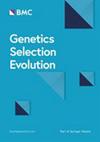Correcting overestimation of approximate traditional reliabilities with herd-sire interactions when young genomic bulls are used in few herds
IF 3.1
1区 农林科学
Q1 AGRICULTURE, DAIRY & ANIMAL SCIENCE
引用次数: 0
Abstract
Differential treatment of daughters of the same sire within a herd is modelled as the herd-sire effect. Recent changes in management practices may have led to the extensive use of certain bulls in a limited number of herds. In that case, although the effect can be well accounted for in genetic evaluation models, some approximation methods for reliabilities do not consider it correctly, leading to an overestimation of some sires’ approximated reliabilities. This study assessed the potential bias of these approximated reliabilities due to the herd-sire effect in both simulated and real dairy cattle records. Two existing methods were tested: Misztal–Wiggans, which includes a specific modification for herd-sire, and Tier–Meyer, which does not. We also modified and tested a Tier–Meyer method considering the herd-sire effect. We observed that in the presence of the herd-sire effect, reliabilities obtained by approximations were overestimated by the Tier–Meyer method for sires with many daughters in a limited number of herds. This was true even for sires with a large number of daughters. The Misztal–Wiggans method performed correctly. We introduced a modified Tier–Meyer method that weighs the information transmitted by the daughter to the sire as a function of the herd-sire information. As a result, the modified Tier–Meyer method performed well in both simulated and real data. For cows, the inclusion of the herd-sire effect had minimal impact. This study identified possible overestimation of approximated reliabilities of sires with daughters concentrated in a few herds when there is a herd-sire effect. This bias occurs when the herd-sire effect is not correctly modeled in reliability approximation methods. Methods that specifically accounted for the herd-sire effect produced unbiased reliability estimates.在少数畜群中使用年轻的基因组公牛时,纠正对近似传统可靠性的高估
在一个畜群中,对同父异母的差别待遇被建模为畜群-父系效应。最近管理实践的变化可能导致在数量有限的畜群中广泛使用某些公牛。在这种情况下,尽管遗传评估模型可以很好地解释这种影响,但一些可靠性的近似方法没有正确考虑它,导致对某些品种的近似可靠性的高估。本研究在模拟和真实的奶牛记录中评估了这些近似可靠性的潜在偏差,这是由于羊群-父系效应。他们测试了两种现有的方法:一种是Misztal-Wiggans,它包含了对群居父系的特定修改,另一种是Tier-Meyer,它没有。考虑到羊群效应,我们还对Tier-Meyer方法进行了改进和测试。我们观察到,在存在畜群-父系效应的情况下,用Tier-Meyer方法对有限数量的畜群中有许多子代的父系获得的近似可靠性被高估了。即使是有很多女儿的父亲也是如此。Misztal-Wiggans方法是正确的。我们引入了一种改进的Tier-Meyer方法,将子代传递给父代的信息作为群居信息的函数进行加权。结果表明,改进后的Tier-Meyer方法在模拟和实际数据中均具有良好的性能。对奶牛来说,包含群居父系效应的影响最小。本研究发现,当存在畜群-畜群效应时,对集中在少数畜群中的母畜与子畜的近似可靠性可能存在高估。当在可靠性近似方法中没有正确地模拟群居效应时,就会出现这种偏差。专门考虑群居效应的方法产生了无偏的可靠性估计。
本文章由计算机程序翻译,如有差异,请以英文原文为准。
求助全文
约1分钟内获得全文
求助全文
来源期刊

Genetics Selection Evolution
生物-奶制品与动物科学
CiteScore
6.50
自引率
9.80%
发文量
74
审稿时长
1 months
期刊介绍:
Genetics Selection Evolution invites basic, applied and methodological content that will aid the current understanding and the utilization of genetic variability in domestic animal species. Although the focus is on domestic animal species, research on other species is invited if it contributes to the understanding of the use of genetic variability in domestic animals. Genetics Selection Evolution publishes results from all levels of study, from the gene to the quantitative trait, from the individual to the population, the breed or the species. Contributions concerning both the biological approach, from molecular genetics to quantitative genetics, as well as the mathematical approach, from population genetics to statistics, are welcome. Specific areas of interest include but are not limited to: gene and QTL identification, mapping and characterization, analysis of new phenotypes, high-throughput SNP data analysis, functional genomics, cytogenetics, genetic diversity of populations and breeds, genetic evaluation, applied and experimental selection, genomic selection, selection efficiency, and statistical methodology for the genetic analysis of phenotypes with quantitative and mixed inheritance.
 求助内容:
求助内容: 应助结果提醒方式:
应助结果提醒方式:


